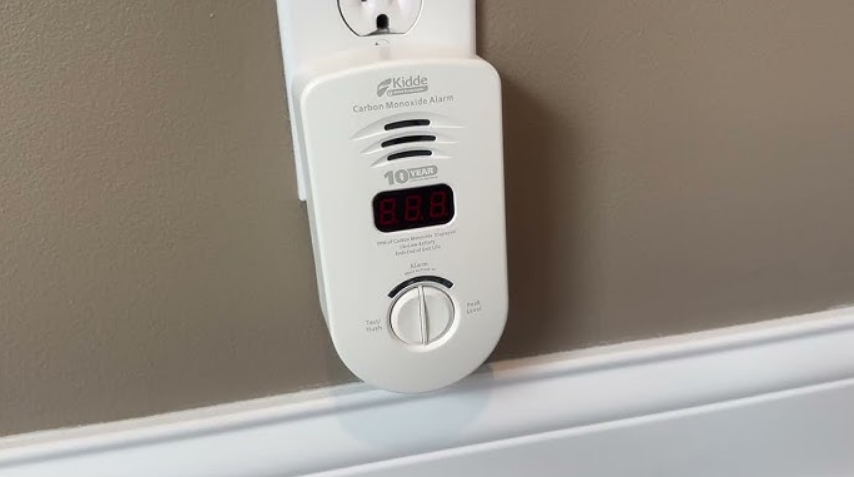
Kidde Nighthawk KN-COP-DP Carbon Monoxide Alarm
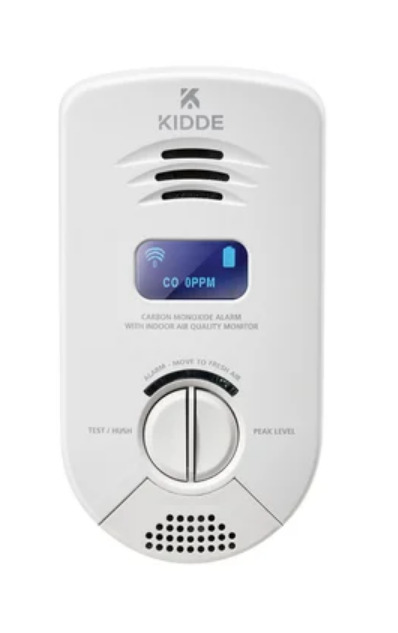
Introduction
This Nighthawk carbon monoxide (CO) alarm is an important part of your family’s home safety plan. So important, the U.S. Consumer Product Safety Commission (CPSC) recommends that every household have at least one carbon monoxide alarm. In fact, the CPSC chairman has said that CO alarms are “as important to home safety as smoke alarms.” Yet because CO alarms for the home haven’t been available until recently, most people haven’t had much experience using them. As a new owner of a CO alarm, there are some basic facts you should know for your protection and convenience. Many people think that CO alarms operate like smoke alarms. And in some basic ways, this is true. Like smoke alarms, CO alarms continuously monitor the air in your home and sound a loud alarm to warn you of trouble. But the similarities end here. The way you respond to a CO alarm is quite different than that of a smoke alarm. That’s because a house fire and a carbon monoxide problem are two distinctly different situations. If your smoke alarm were to alarm, you would quickly be able to judge the level of danger you were in (if any) with your five senses: you could see and smell the smoke, you could feel the heat, and you could see and even hear the fire burning. You could also readily see if your smoke alarm was alarming in a non-emergency situation, say if someone smoked up the kitchen with some seriously burnt toast. Because your sense of sight, smell, hearing, and touch give you so much information, you could almost instantly judge what action to take if you heard your smoke alarm. But now, what about a CO alarm? Carbon monoxide (CO) is invisible, odorless, tasteless, and non-irritating–completely undetectable to your five senses. That’s why it’s so important to your safety that you have a carbon monoxide alarm. But, how do you know what to do if your unit alarms? You have to learn what to do, because your five senses won’t tell you. That’s why this user’s guide is so important. Please take the time to read this guide from cover to cover, to familiarize yourself with the facts about carbon monoxide, how your new alarm works, and what to do if it alarms. Then, find a handy place to keep the guide so it will be readily available in the future when you have a question. You might want to write down KIDDE Safety’s toll-free customer service number and keep it with your other important phone numbers for the same reason. Thank you for making Nighthawk a part of your complete home safety program. With proper installation and use, your new Nighthawk CO alarm should provide you with years of dependable service.
Quick Set Up Guide
We urge you to read this entire manual in the sequence it is presented. But, if you only read one part of this manual initially, read these two pages!
Listed below are six easy steps for setting up your Nighthawk CO alarm. Please read the entire guide for complete information.
Setting up your CO alarm for first-time operation:
- Step 1
Determine the best location for your CO alarm(s). Usually, this is in or near bedrooms. Refer to pages 1-5 for complete information. - Step 2
If your CO alarm is equipped with a power cord, mount the alarm on the wall at eye level using the hardware provided. Eye level is the best position to see the digital display easily. If your CO alarm is equipped with a direct plug, plug it in (you can rotate the plug if necessary). For hardwire units and for detailed instructions on mounting all alarms, refer to pages 1-7,8. - Step 3
Plug the CO alarm into a standard, unswitched 120-volt AC electric outlet. If you have a direct plug model, mount the CO alarm with a digital display at the top. You will hear the alarm sound briefly to indicate the unit is receiving power. Refer to pages 1-9 for more details. - Step 4
You will first see three eighths in the digital display, indicating the CO alarm is warming up. After approximately 30 seconds, the first reading will appear on the digital display. The number on the digital display should be zero (0). If not, see pages 1-9 for complete information on normal operating characteristics. - Step 5
Make sure the red dot in the digital display is blinking. Then test the alarm’s operation by pressing the Test/Reset button and releasing. Within 15 seconds, you will hear 4 quick beeps – 5 seconds off – then 4 quick beeps. For complete testing information, refer to pages 1-10. - Step 6
While testing the alarm, have someone else check that the alarm can be heard easily from the sleeping areas. The CO alarm should be located where it can wake you if it alarms at night. See page 1-5 for complete information on the best locations for your CO alarm.
Caution: Continuous exposure to the loud 85 decibel alarm at close range over an extended period of time may cause hearing loss. That’s it. Your Nighthawk CO alarm is now monitoring for the presence of carbon monoxide.
Part One – Your Nighthawk CO Alarm
About Your CO Alarm
The number one feature that sets Nighthawk apart from other alarms is its unique digital display that gives you a continuous readout of CO levels from 30-999 parts per million. The digital display serves as an early warning of CO presence. Additionally, the digital display gives you added time to find the source of the CO and correct the problem, limiting the risk of unrecognized long-term exposure. Of course, the loud 85 decibel alarm warns of higher levels, even while you’re sleeping. While many other CO alarms require costly sensor or battery pack replacement, there are no replacement parts on Nighthawk CO alarms. And Nighthawk is the only CO alarm that gives you the choice of a direct plug, a 6-foot power cord, or a hardwire unit. Depending on how or where you wish to mount your alarm, you can get exactly what you need for a perfect application. These are just a few reasons over 4.5 million families have chosen Nighthawk over every other brand for this kind of life-saving protection.
Nighthawk CO Alarm – front view
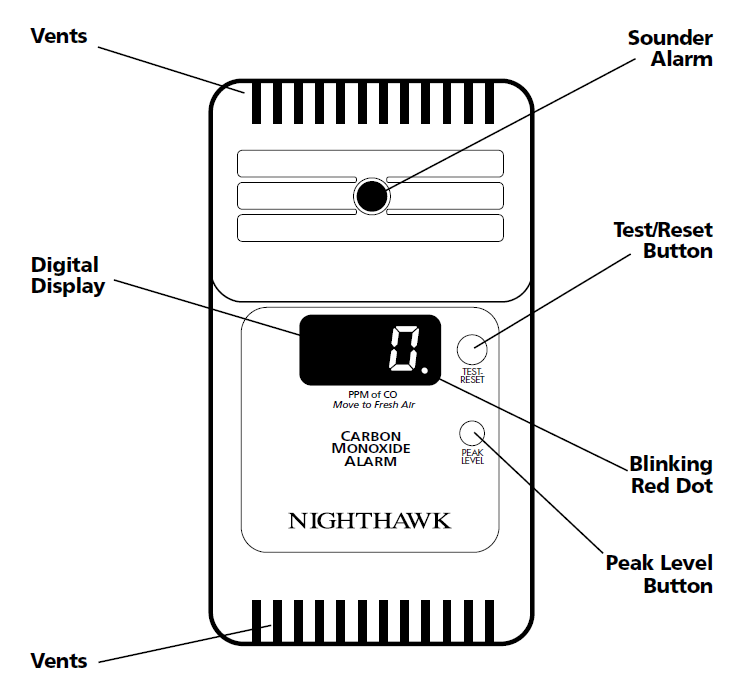
Nighthawk CO Alarm– rear view
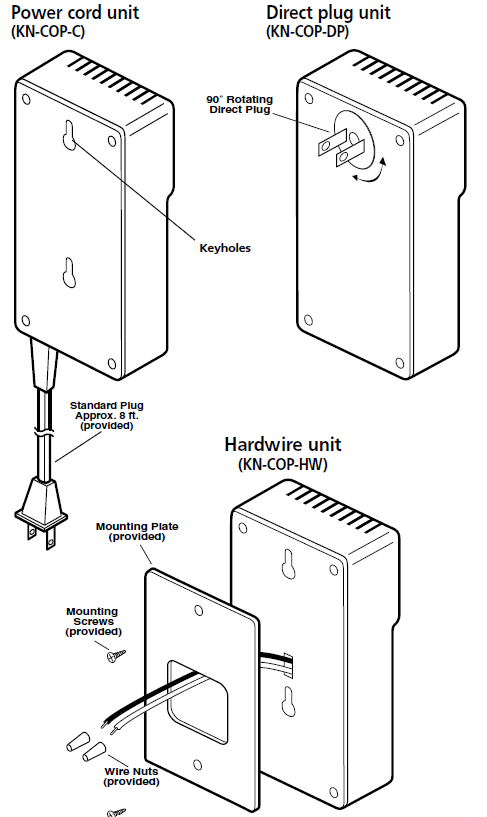
Nighthawk’s Unique Features
Digital Display
This continuous digital display shows you the level of carbon monoxide (if any) the unit is sensing. The unit updates this reading every 15 seconds so you can watch levels rise or fall.
Note: If the alarm does not sense any CO, the reading is zero (0). In most homes, the alarm reads “0” all the time. A reading of “0” is expected under normal conditions and is good. The blinking dot after the number shows you the unit is operating.
- Test/Reset Button
This button has two functions. First, this is the button you press when you test the unit weekly (see pages 1-9,10,11 for further details). Secondly, you press this button if the unit alarms and you want to turn it off. This will reset the unit, and it will then again start monitoring for CO. If the CO concentration is above 70 ppm, the CO alarm will sound within 60 minutes. (More on this on page 5-2). - Peak Level Button
By depressing this button, you can see the peak CO level recorded by the alarm since it was last reset or unplugged. This Nighthawk feature allows you (or a heating contractor or fireman) to see exactly how big a CO problem you have so you can react accordingly. (More on the peak level memory feature on pages 1-14). - Vents
Air (and CO) enters the alarm at the bottom vent and circulates through the sensing chamber, exiting through the top vent. For proper air circulation, keep vents free of dust, dirt, or grease (see “How to care for your CO alarm” page 1-13). Do not obstruct or block vents (see “Where to install your CO alarm” on pages 1-5). - Sensor
The sensor is a highly sensitive, electrochemical sensor that is CO-specific to help avoid false alarms. Turn to pages 1-13 for more information on how to care for and protect the CO alarm. - Sounder Alarm
This is the loud 85 decibel pulsing alarm that will sound to alert you to a potential problem. Alarm condition is 4 quick beeps – followed by 5 seconds off – then 4 quick beeps, repeat. Caution: Continuous exposure to this sound level at close range over an extended period of time may cause hearing loss. We recommend you cover the sounder with your finger while testing. More on testing on pages 1-10,11. - Keyholes
When the CO alarm is mounted to the wall, these keyholes slide onto the screws in the wall. (See “How to install your CO alarm on pages 1-7,8).
Part Two – Carbon Monoxide – The Silent Killer
Home Safety Tips
What You Can Do…
- Buy only appliances approved by a nationally recognized testing laboratory.
- Choose fuel-burning appliances that can be vented to the outdoors, whenever possible.
- Make sure appliances are installed according to the manufacturer’s instructions and local building codes. Most appliances should be installed by professionals and should be inspected by the proper authority after installation.
- Have the heating system, vents, chimney, and flue inspected and cleaned by a qualified technician every year.
- Follow the manufacturer’s directions for safe operation of all fuel-burning appliances.
- Examine vents and chimneys regularly for improper connections, visible rust, or stains.
- Open a window when a fireplace or wood-burning stove is in use, and provide adequate outdoor air for the furnace and water heater.
- Notice problems that could indicate improper appliance operation:
- Decreasing hot water supply
- The furnace is unable to heat the house or runs constantly
- Sooting, especially on appliances
- Unfamiliar or burning odor
- Yellow or orange flame
- Be aware of the symptoms of carbon monoxide poisoning:
- headaches, dizziness, weakness, sleepiness, nausea, vomiting, confusion, and disorientation.
- Recognize that CO poisoning may be the cause when family members suffer from flu-like symptoms that don’t disappear but improve when they leave home or after extended periods of time.
- Install a UL 2034 Listed CO alarm for added safety.
- The Consumer Product Safety Commission recommends that every residence with fuel-burning appliances be equipped with a UL-listed CO alarm.
Be Aware of the Warning Signs of Carbon
Monoxide: Clues You Can See…
- Streaks of carbon or soot around the service door of your fuel-burning appliances.
- A yellow or orange flame may indicate a problem with natural gas appliances.
- Excessive rusting on flue pipes or appliance jackets.
- Loose or missing furnace panel.
- Moisture is collecting on the windows and walls of furnace rooms.
- Loose or disconnected vent/chimney, fireplace, or appliance.
- Small amounts of water are leaking from the base of the chimney, vent, or flue pipe.
- Rust on the portion of the vent pipe visible from outside your home.
- The absence of a draft in your chimney (indicating blockage).
- Fallen soot from the fireplace chimney.
- Loose, damaged, or discolored bricks on your chimney.
Clues You Cannot See…
- Internal appliance damage or malfunctioning components
- Improper burner adjustment
- Hidden blockage or damage in chimneys
Part Three – What You Should Know Before the Alarms Sound
Learn the difference between dangerous levels, high levels, mid levels, and low levels:
Dangerous levels occur when someone is experiencing symptoms of CO poisoning, and CO readings are generally above 100 ppm. Anytime someone is experiencing the symptoms of carbon monoxide poisoning this should be treated as an EMERGENCY. Follow the instructions on page 4-2. High levels, generally above 100 ppm, with no one experiencing symptoms. This should be treated as an URGENT situation. Follow the instructions on page 4-2. Mid levels, generally between 50 ppm and 100 ppm. This should be cause for CONCERN and should not be ignored or dismissed. Follow
the instructions on page 4-2. Low levels, generally below 50 ppm. This indicates a need to watch the situation closely to see if it resolves itself or worsens. Follow the instructions on page 4-3.
Determine if anyone in the household is at high risk for CO poisoning:
Many cases of reported carbon monoxide poisoning indicate that while victims are aware they are not well, they become so disoriented that they are unable to save themselves by either exiting the building or calling for assistance. You should take extra precautions to protect high-risk persons from
CO exposure because they may experience ill effects from carbon monoxide at levels that would not ordinarily affect a healthy adult. Are there any infants or small children in the home? Be sure to check them for signs of possible CO poisoning because they might have trouble explaining their symptoms. Infants and children are more susceptible to CO poisoning than healthy adults. Pregnant women should be aware that their unborn fetus could be harmed by exposure to carbon monoxide, even when the mother suffers no ill effect herself. Any pregnant woman who suspects she may have been exposed to carbon monoxide should immediately contact her physician. Is there anyone in the household who is elderly, or who has anemia, heart disease, or respiratory problems, emphysema, or chronic bronchitis? These individuals are at higher risk for CO poisoning and for health problems from exposure to low levels of carbon monoxide. If anyone in the household is at high risk for CO poisoning, we urge you to take extra precautions to prevent possible poisoning. If the unit alarms or if CO readings are shown on the digital display, remove the at-risk
person from the premises, if possible. Ventilate the area. The high-risk person(s) should not re-enter the residence until the source of the CO problem has been identified and corrected.
Understand the Effects of Carbon Monoxide Exposure
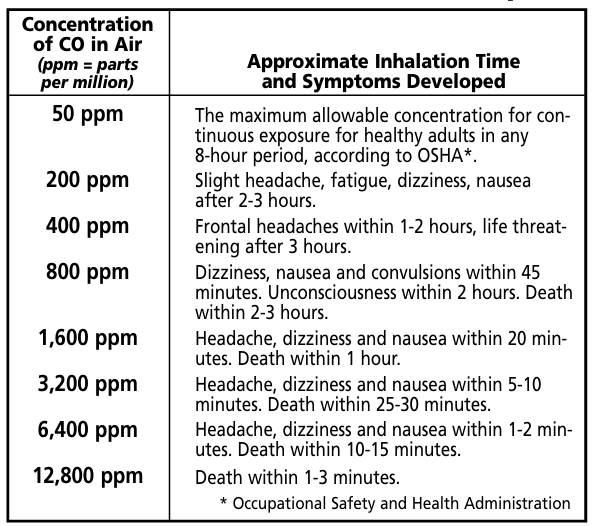
Part Four – What to do When the Alarm Sounds
Determine if anyone in the household is experiencing symptoms of CO poisoning. Many cases of reported CO poisoning indicate that while victims are aware they are not well, they become so disoriented that they are unable to save themselves by either exiting the building or calling for assistance. Also, young children and household pets may be the first affected. The following symptoms are related to CARBON MONOXIDE POISONING and should be discussed with ALL members of the household:
- Common Mild Exposure Symptoms:
Slight headache, nausea, vomiting, fatigue (“flu-like” symptoms). - Common Medium Exposure Symptoms:
Throbbing headache, drowsiness, confusion, and fast heart rate. - Common Extreme Exposure Symptoms:
Convulsions, unconsciousness, heart and lung failure. It can cause brain damage and death.
When the CO alarm senses a dangerous level of CO, the unit will emit a loud alarm pattern. The alarm pattern is 4 short beeps – followed by 5 seconds of silence – followed by 4 short beeps. Know how to respond to a CO emergency. Periodically review this user’s guide and discuss with all members of your family.
WARNING! – Actuation of this device indicates the presence of dangerous levels of carbon monoxide!
Carbon monoxide can be fatal! If the alarm sounds:
- Operate test/reset button;
- Call your emergency services (fire dept. or 911);
- Immediately move to fresh air – outdoors or by an open door/window. Do a head count to check that all persons are accounted for. Do not reenter the premises nor move away from the open door/window until the emergency services responders have arrived, the premises have been aired out, and your alarm remains in its normal condition.
- After following steps 1-3, if your alarm reactivates within a 24-hour period, repeat steps 1-3 and call a qualified technician to investigate for sources of CO from fuel-burning equipment and appliances, and inspect for proper operation of this equipment. If problems are identified during this inspection, have the equipment serviced immediately. Note any combustion equipment not inspected by the technician and consult the manufacturer’s instructions, or contact the manufacturer directly, for more information about CO safety and this equipment. Make sure that motor vehicles are not, and have not been, operating in an attached garage or adjacent to the residence.
Sometimes it’s Difficult to Find the Source of CO in a Home
It can be difficult for responders to locate the source(s) of CO if:
- The house was ventilated before they arrived, and the fresh air caused the CO to dissipate. The peak level function on your Nighthawk CO alarm helps the responders know how severe the problem was before they arrived.
- The CO problem was caused by a source that fluctuates on and off, sometimes creating CO and sometimes not. Such a situation makes it nearly impossible to pinpoint the source of CO in a short period of time.
- The cause of CO problem was backdrafting – when air in a chimney or flue is sucked into the home instead of venting outside. The exact situation that created a negative air pressure inside the home (the cause of backdrafting) is difficult to recreate during an investigation for CO. Sometimes, the CO problem disappears when a door or window is opened. Backdrafting may or may not happen again.
Part Five – Technical Information
- Power: 120V AC units: 60 Hz, Current 60 mA max.
- Sensor: Sensor calibrated at 150 ppm (±25 ppm).
- Temperature:
- Operating range: 40°F (4.4°C) to 100°F (37.8°C).
- Mounting: Power Cord: #8 Philips panhead screw with plastic anchor.
- Hardwire: 2, #8 Philips panhead screws with mounting plate.
- Direct Plug-In: No mounting screws needed.
- Alarm: 85+ dB at 10’ @ 3.4 ± 0.5 KHz pulsing alarm. In alarm condition, you will hear 4 quick beeps, 5seconds off, 4 quick beeps, repeat.
- LED Operation: Blinking dot denotes normal operation. Digital readout 30-999.
- Unit Malfunction: “Err” error message will display. An intermittent alarm will sound every 30 seconds, and the display dot will stop blinking. Refer to pages 1-12 for other “Err” conditions.
- Test/Reset Button: The Test button verifies proper unit operation and resets the unit in the event of a CO alarm.
- Peak Level Memory Button: When pressed, the LED will display the highest CO ppm level detected since the unit was powered up or since unit was reset with the test button. Reading will be stored in memory as long as the unit is not reset or unplugged. Any concentration detected from 0-999 will be displayed.
- Size: 5.6” L x 3.2” W x 2.0” H. Wt. 1.1 lbs.
- Housing: Rigid plastic case meets UL94-5V rating.
- Warranty: Five-year warranty from date of purchase against defects in material and workmanship.
Part Six – Frequently Asked Questions
- Q. How many alarms do I need in my house? How much square footage will one CO alarm cover?
A. We recommend you place alarms near the sleeping area(s). If you have a multi-level home, you should place an alarm on each level of the home. A good rule of thumb for the number and placement of CO alarms for your particular home is to place CO alarms near smoke alarms that have been installed to meet current building code requirements. Generally, one CO alarm can be adequate for 1,200 to 1,500 square feet of living space. The most important determination for the number of alarms needed is whether an alarm can be heard in all sleeping areas. - Q. Can you explain what “time-weighted alarm” means?
A. Because carbon monoxide is a cumulative poison, two factors determine how the body is affected by CO: the level of exposure and the length of exposure. For example, being continuously exposed to low levels of carbon monoxide for many hours can be as dangerous as being exposed to higher levels of CO for a short period of time. The microchip inside your Nighthawk CO alarm monitors the air for the presence of carbon monoxide and computes the levels and length of exposure, alarming when you should be concerned about CO exposure. For more information about the alarm, see page 5-2. - Q. Do I have to press the test button to get a CO reading?
A. No. Your Nighthawk CO alarm continuously monitors the air for carbon monoxide. An updated reading is shown on the digital display every 15 seconds. If there is no CO present, the digital display will show a zero. The CO alarm will alert you to the presence of CO automatically. To test the internal components and circuitry of your CO alarm, press the Test/Reset button. For complete instructions on testing your CO alarm, see pages 1-10,11. - Q. My CO alarm shows a reading of 30 ppm and then drops immediately to “0” ppm., What causes this?
A. Per UL2034 (section 3,19), which states “Warning signal: except for alarm and trouble signals, no other audible and visual signals shall be used. (ie, warning signals that indicate the presence of CO less than 30 ppm.)”. Nighthawk CO alarms cannot display CO concentrations detected below 30 ppm. Under normal conditions, however, by pressing the peak level button, concentrations of CO detected below 30 ppm will be displayed.
Limited Warranty
WARRANTY COVERAGE: THE MANUFACTURER WARRANTS TO THE ORIGINAL CONSUMER PURCHASER, THIS PRODUCT WILL BE FREE OF DEFECTS IN MATERIAL AND WORKMANSHIP FOR A PERIOD OF FIVE (5) YEARS FROM DATE OF PURCHASE. THE MANUFACTURER’S LIABILITY HEREUNDER IS LIMITED TO REPLACEMENT OF THE PRODUCT. REPAIR OF THE PRODUCT OR REPLACEMENT OF THE PRODUCT WITH REPAIRED PRODUCT AT THE DISCRETION OF THE MANUFACTURER. THIS WARRANTY IS VOID IF THE PRODUCT HAS BEEN DAMAGED BY ACCIDENT, UNREASONABLE USE, NEGLECT, TAMPERING OR OTHER CAUSES NOT ARISING FROM DEFECTS IN MATERIAL OR WORKMANSHIP. THIS WARRANTY EXTENDS TO THE ORIGINAL CONSUMER PURCHASER OF THE PRODUCT ONLY.
For more manuals by Kidde, visit ManualsLibaryy
Kidde Nighthawk KN-COP-DP Carbon Monoxide Alarm-FAQs
What is the Kidde Nighthawk KN-COP-DP carbon monoxide alarm used for?
It is designed to alert you when dangerous levels of carbon monoxide (CO) are detected in your home, helping protect your family from CO poisoning.
Why is my Kidde Nighthawk alarm beeping?
Beeping can indicate several things: four beeps mean dangerous CO is present, while intermittent chirps usually mean a low battery, sensor error, or end-of-life warning.
How long does a Kidde Nighthawk CO detector last?
Most models, including the KN-COP-DP, have a lifespan of 7 to 10 years. After this period, the alarm should be replaced.
At what level does the alarm go off?
The detector is programmed to sound at higher CO concentrations, typically above 30 ppm, with faster response at higher levels for safety.
How can I stop the alarm from beeping every 30 seconds?
A chirp every 30 seconds often means the unit has reached its end of life. It cannot be reset—replace the alarm immediately.
Where should I place my Kidde CO alarm?
Install it near sleeping areas and on each level of your home, about five feet above the floor for accurate detection.
What do the indicator lights mean on the Kidde Nighthawk?
A green light means normal operation, red signals an active alarm, and amber indicates an error or malfunction.
Can I replace the batteries in this alarm?
Yes, the plug-in unit includes a backup battery that should be replaced when low-battery chirps occur.
What should I do if the alarm goes off?
Immediately move everyone outside to fresh air, call 911, and do not re-enter your home until professionals confirm it is safe.

